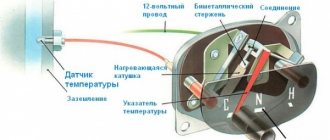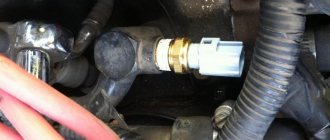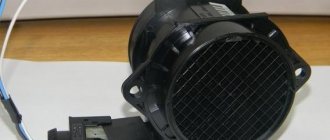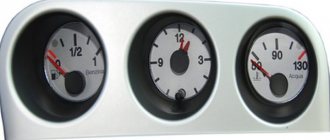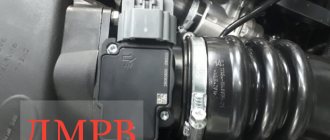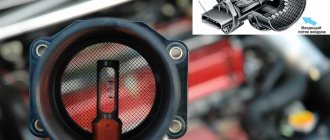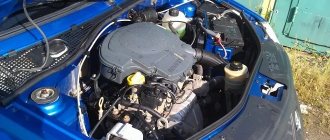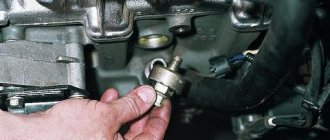What is an intake air sensor and where is it located?
The intake air temperature sensor (abbreviated as ДТВВ, or IAT in English) is needed to adjust the composition of the fuel mixture supplied to the engine. This is necessary for normal operation of the motor in different temperature conditions. Accordingly, an error in the intake air temperature sensor into the manifold threatens excessive fuel consumption or unstable engine operation.
DTVV is located on the air filter housing or behind it . It depends on the design of the car. It is performed separately or can be part of the mass air flow sensor (MAF).
Places where the intake air temperature sensor is located
How to recognize a detector malfunction?
The main signs of detector failure are the following:
- difficulty starting the engine at low ambient temperatures;
- failures at idle speed;
- excessive fuel consumption;
- interruptions in engine operation;
- error code in the on-board unit or flashing of the corresponding indicator.
The fact that the thermistor stops transmitting correct data leads to errors in calculating the level of enrichment of the fuel mixture and its subsequent overconsumption. This is because the sensor reports that the intake air temperature is low, causing the system to mix less air with fuel than required. And here it is - the extra gasoline flies away where it shouldn't. In addition, oversaturation of the mixture with fuel can lead to flooding of the spark plugs, which can lead to their failure.
Intake air temperature sensor malfunctions
There are several signs of a malfunctioning intake air temperature sensor. Among them:
- interruptions in engine operation at idle (especially in the cold season);
- Engine idle speed is too high or low;
- problems with starting the engine (in severe frosts);
- reduction in engine power;
- excess fuel consumption.
Malfunctions may be due to the following reasons:
- mechanical damage to the sensor caused by exposure to solid particles;
- loss of sensitivity due to contamination (increased inertia of transient processes);
- insufficient voltage in the car's electrical system or poor electrical contacts;
- failure of the sensor signal wiring or its incorrect operation;
- short circuit inside IAT;
- contamination of the sensor contacts.
Checking and cleaning DTVV.
How to replace DTVV on Lanos
If you are convinced that the element in question on the Lanos car is faulty, then it should be replaced. The replacement principle is not difficult, and it can be done in two ways:
- Replacement together with the inlet pipe. This method is suitable in cases where the pipe is damaged. Moreover, this applies even to small cracks through which polluted air begins to leak.
- Only the sensor is changed, and the pipe remains in its place
If the inlet air temperature sensor is replaced along with the air supply hose, then this procedure is performed in the following way:
- You need to loosen the fastenings of two clamps
- Disconnect the chip from the sensor
- Using pliers, loosen the clamp of the pipe that is connected to the hose
- Remove the air supply sleeve along with the built-in sensor and replace it
This completes the process of replacing the device along with the air supply pipe. A video description of the replacement is presented below.
What to do if the supply hose does not need to be replaced? The sensor is glued into the hole in the air supply sleeve. Instructions on how to independently replace the DTVV on Lanos without removing the pipe are as follows:
- Using a construction knife, you should disconnect the element from the pipe from the outside. It is more convenient to carry out work with the air supply hose removed
- After disconnecting the device, it should be removed and the seat should be cleaned
- Install the new sensor into the prepared hole. It is glued with adhesive
This completes the sensor replacement process. All that remains is to connect the chip to it and carry out the tests.
Checking the intake air temperature sensor
Before checking the intake air temperature sensor, you need to understand the principle of its operation. The sensor is based on a thermistor. Depending on the temperature of the incoming air, the DTVV changes its electrical resistance. The signals generated by this are sent to the ECM in order to obtain the correct fuel mixture ratio. Diagnosis of the intake air temperature sensor must be performed based on measuring the resistance and the magnitude of the electrical signals emanating from it.
The test begins with calculating the resistance . To do this, use an ohmmeter by removing the sensor from the car. The procedure is carried out by disconnecting two wires and connecting them to a measuring device (multimeter). The measurement is carried out in two engine operating modes - “cold” and at full speed.
Supply voltage measurement
Sensor resistance measurement
In the first case, the resistance will be high-resistance (several kOhms). In the second - low-resistance (up to one kOhm). The operating instructions for the sensor must contain a table or graph with resistance values depending on temperature. Significant deviations indicate improper operation of the device.
As an example, we present a table showing the relationship between temperature and resistance of the intake air sensor for the engines of the VAZ 2170 Lada Priora car:
| Intake air temperature, °C | Resistance, kOhm |
| –40 | 39,2 |
| –30 | 23 |
| –20 | 13,9 |
| –10 | 8,6 |
| 0 | 5,5 |
| +10 | 3,6 |
| +20 | 2,4 |
| +30 | 1,7 |
| +40 | 1,2 |
| +50 | 0,84 |
| +60 | 0,6 |
| +70 | 0,45 |
| +80 | 0,34 |
| +90 | 0,26 |
| +100 | 0,2 |
| +110 | 0,16 |
| +120 | 0,13 |
At the next stage, check the connection of the conductors to the control device . That is, using a tester, make sure there is continuity of each contact to ground. Use an ohmmeter, which is connected between the temperature sensor connector and the disconnected connector of the control device. In this case, the value should be 0 ohms (note that you need a contact diagram for this). Check each contact on the sensor connector with an ohmmeter with the connector disconnected against ground.
Measuring DTVV resistance in Toyota Camry XV20
For example, to check the sensor resistance on a Toyota Camry XV20 with a 6-cylinder engine, you need to connect an ohmmeter (multimeter) to the 4th and 5th terminals of the sensor (see figure).
However, most often the DTVV has two thermistor outputs, between which it is necessary to check the resistance of the element. We also bring to your attention the IAT connection diagram in the Hyundai Matrix car:
Connection diagram for DTVV with DBP for Hyundai Matrix
The final stage of the test is to find out the supply voltage at the connector . In this case, you must turn on the car's ignition. The magnitude of the electrical signal should be 5 V (for some DTVV models this value may differ, check it in the passport data).
The intake air temperature sensor is a semiconductor device. Accordingly, its configuration is impossible. It is only possible to clean the contacts, check the signal wires, and also completely replace the device.
Inspection and repair
The temperature sensor may be damaged due to pressure in the intake manifold. Mineral solids and oil contamination can cause the indicator to lose sensitivity. The service life also plays a big role. Many sensor problems are caused by poor voltage or electrical contacts inside the device. The location of the device also makes it likely that the wiring or terminals between the detector and the control unit will rust.
Symptoms of a malfunctioning intake air temperature sensor:
- Engine interruptions when idling;
- Too sharp or, on the contrary, slow engine speed at idle;
- The engine cannot be started.
The consequences of a malfunction of the mechanism for determining the intake air temperature can be very different. For example, too much fuel consumption or rough idling (due to the fact that the injectors cannot start from a cold start). In addition, a malfunction of this system increases the risk of vehicle detonation.
Photo - how the sensor is connected in Japanese cars
Checking the intake air temperature sensor for resistance is carried out as follows: you need to use a diagnostic tool to determine the difference in coolant temperature and the indicators of the detector. Resistance is checked with an ohmmeter.
Intake air temperature sensor repair
How to repair an explosive temperature sensor.
The simplest type of IAT repair is cleaning . To do this, you will need some kind of cleaning liquid (carb cleaner, alcohol, or other cleaner). However, remember that you need to work carefully so as not to damage the external contacts .
If you encounter a problem where the sensor shows the wrong temperature, instead of completely replacing it, you can repair it. To do this, buy a thermistor with the same or similar characteristics as the thermistor already installed on the car.
The essence of the repair is to re-solder and replace them in the sensor housing. To do this you will need a soldering iron and the appropriate skills. The advantage of the repair is significant savings in money, because the thermistor costs about a dollar or less.
Replacing the intake air temperature sensor
The replacement procedure is not difficult and does not take much time. The sensor is mounted on 1-4 bolts that need to be unscrewed, and also with a simple movement, disconnect the power connector to remove the incoming air sensor from its place.
When installing a new DTVV, be careful not to damage the contacts, otherwise the device will fail.
When purchasing a new sensor, make sure that it is suitable for your car. Its price ranges from $30...60 depending on the car brand and manufacturer.
How to choose a new sensor
A car enthusiast has several search methods. Everyone is good in their own way, but the main thing here is the result. As practice shows, you can choose a sensor from China that suits its characteristics at a cheap price, and it will work for quite a long time. The device is very simple, so if you come across similar ones, you can buy them. So, here's how you can find the original and analogues:
- Search by VIN code . The chance of finding the wrong device is zero. This is the easiest way to find the original, and in accordance with its characteristics, the store manager will “pull up” analogues;
- According to the car . We are talking about the following data: make, model, engine parameters, equipment, year of manufacture. It often happens that one sensor from the aftermarket can be installed in an entire fleet of vehicle models. Most likely, a search using transport data will give you many matches, so you will have to choose further based on information about the manufacturers (we will talk about this later);
- Search in electronic catalogs . You can find hundreds of offers online for the same spare part. The search criterion will be either the transport code or its data. And again you need to understand the manufacturers.
Thus, if the driver does not want to spend a lot of time searching, he can search by vehicle code and take the original. The choice of analogues is a more delicate matter and requires free time.

